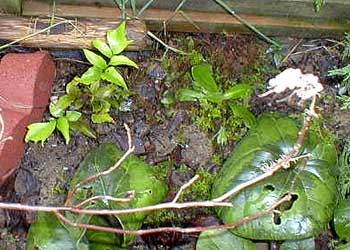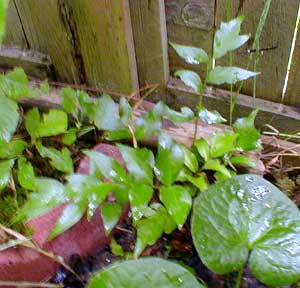
Japanese Holly Fern; or,
Asian Net-veined Hollyfern; or,
Fortune's Arching Hollyfern
"In the rough fern-clad park, the herded deer
Shook the still-twinkling tail & glancing ear."
-William Wordsworth
1770-1850
1770-1850
The first March (2003) photo shows an infant Hardy Japanese Holly Fern getting started at the foot of a Summersweet bush, not far distant from a patch of Chinese Giant Asarum.
This is Cyrtomium fortunei & I think it may even be var. intermedia which restricts its fronds to between six & twelve pairs of pinnae. I'm not more certain of it being the variant, since it was obtained cheaply & untagged during a nursery sale.
 I brought it home & popped into the ground late in Autumn 2002. It did not grow during the winter of course, but the cold weather caused it no harm as it waited for spring, as this species is by far the most cold-hardy of the Cyrtomium species. By spring 2005 it had grown some of course, but not a lot. It never looks like it is struggling, but it stays rather dwarfish with so many large things greatly overshadowing.
I brought it home & popped into the ground late in Autumn 2002. It did not grow during the winter of course, but the cold weather caused it no harm as it waited for spring, as this species is by far the most cold-hardy of the Cyrtomium species. By spring 2005 it had grown some of course, but not a lot. It never looks like it is struggling, but it stays rather dwarfish with so many large things greatly overshadowing.It needs persistent moisture, but dislikes outright sogginess, as does the summersweet it is under, so they struck me as likely good companions when I first troweled the young fern into the ground. In retrospect I'm a little annoyed by my choice of location only because it is entirely invisible except when I move aside other foliage to check on it. I had to hold summersweet branches aside to snap the overhead picture, & had to get down nearly on my belly to snap the second photo in September, when the holly fern had grown only a bit.
Its spot is extremely shady except in winter & early spring when the summersweet is leafless & lets some sunlight against the fence. Holly Ferns supposedly do like full shade over partial shade, so I left it right where I initially planted it, while hoping in time it wiykd be large enough to show more of itself without my having to part foliage to see it at all.
In the meantime, I obtained a specimen of the similar-looking but much larger C. falcatum to put in a more overt location where it could be more fully enjoyed. It too is in pretty deep shade, but much more vigorous without so many big things so closely crowding & overshadowing it. We also added C. caryotideum the dwarf netvein or fishtail holly fern to the ledge of a raised shade garden by the flagstone patio.
C. fortunei is notably cold-hardy for zones 5 through 9, being native to Japan, Korea, & China. The fronds are fully evergreen here in Zone 8, & really do look like holly branches, being tough & leathery. By the beginning of spring, when in a sheltered spot, it shows scarsely any winter damage, but might nevertheless be trimmed back to make room for new spring growth. In a more exposed location the leaves will be badly beaten by winter's end, & despite its tough appearance, it is also easily damaged by sun exposure.
Holly ferns are not picky as to soil conditions. C. fortunei likes the acidic loamy soils typical along Puget Sound, but in areas with somewhat more alkaline soils it would still do fine.
Fortune's Hollyfern is upright & fountaining, rarely reaching quite two feet high. For a larger one, C. falcatum sometimes reaches three feet high & wide, but it is not nearly so cold-hardy hence a good choice of holly fern primarily if one lives further south than us.
These are the only two species of Cyrtomium commonly available for gardeners, though others are occasionally seen from fern specialists or sold as houseplants. Both C. fortunei & C. falcatum have received the Award of Garden Merit for beauty & ease of growth. But I prefer C. fortunei for its more certain hardiness. Because C. falcatum has strains native to both temperate & tropical areas of Asia, Asia Minor, & Southeast Asia, reports on its winter hardiness are mixed.
The strain of C. falcatum most commonly sold in the USA (such as by Monrovia) is evidently of tropical or subtropical origin & suffers considerable winter damage in Zone 8 & dies in colder zones. But British gardeners seem to be offered a strain of more northerly Asian origin, sufficiently temperate-hardy for England & Scotland. So C. facatum might be worth a try, though given a choice, the fully temperate-hardy C. fortunei is the one adaptable furthest north.
The species name is after Robert Fortune, the nineteenth century Scottish plant explorer who was the first westerner to describe a great many Chinese species. In China it has been used medicinally, the rhizome being alleged to expel worms.